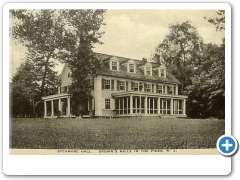
Sycamore Hall
The storied history of Sycamore Hall can still be felt
as the ghosts of a dead diva, eccentric millionaire, a passion plagued murder,
renown doctors, quaint gift shop owner and a failed banker still roam the halls
and rooms and are a part of the historic legacy of the big white house on the
hill overlooking Mirror Lake in Browns Mills, New Jersey.
Now in a new transition, the building is at a new
crossroads, either to be demolished to make room for a strip mall or preserved
as an historic inn, restaurant and tavern, the only two choices on the table at
the moment.
The new owner has a soft spot in her heart
for the historic building to be preserved.
The original building that dates to before 1820 once
served as a health spa and clinic for people with TB and other lung diseases
and breathing problems that afflicted center city dwellers during the smog
infested industrial revolution. The clear air of the pine barons and the cedar
water were promoted for their healthful benefits, and Sycamore Hall was one of
a number of such similar lodges that joined together nearly 100 years ago to
form Deborah Hospital.
The millionaire was Colonel James Fisk, whose
passionate affair with diva actress Josephine Mansfield ended when he was
murdered by another lover Edward S. Stokes.
In 1868 New York railroad tycoon Colonel James Fisk,
Jr. met beautiful Bostonian Helen Josephine Mansfield, a singer and actress who
at the age of 16 married Frank Lawler in 1866 and divorced him in 1867.
Although impoverished an unable to pay rent for her
one room apartment, she at first rebuked the advances of Fisk, who was known to
give $100 bills to attractive women. Eventually she let him pay her overdue
rent and he bought her an elegant home in New York City, furnished it and
provided her with everything she desired including four servants, $50,000 in
cash, a wardrobe of dresses and a case of jewels.
In 1869 Fisk and his partner Jay Gould precipitated what became known as the first "Black Friday" in the world's financial exchanges when they tried to
corner the gold market.
“Friday, September 24, 1869 became known as Black
Friday on Wall Street. The markets opened in a pandemonium as the price of gold
shot up. But then the federal government began to sell gold, and the price
collapsed. Many traders who had been drawn into the frenzy were ruined. Jay
Gould and Jim Fisk came away unscathed. Sidestepping the disaster they had
created, they sold their own gold as the price had risen on Friday morning.
Later investigations showed that they had broken no laws then on the books.
While they had created panic in the financial markets and hurt many investors,
they had gotten richer.”
Fisk spent many vacations secluded at Sycamore Hall, a
Browns Mills hotel with his paramour Mansfield, but Fisk’s lifestyle caught up
with him. On January 6 1872 Fisk was shot and killed by his business associate
Edward S. Stokes, a jealous co-suitor for the attention of the glamorous Mansfield.
This, of course, exposed the scandal.
In 1873 Mansfield and Ella Wesner, a male impersonator
in Vaudeville moved to Paris and presided over the Café American. The 1891 U.S.
silver certificate known as the Courtesan Note depicts the image of a women
that is based on a photograph of Josie Mansfield. She died in Paris and is
buried in the historic Montparnasse Cemetery.
In 1910 real estate developer James B. Reilly rebuilt
Sycamore Hall and in 1920 rebuilt the dam on Mirror Lake and the clubhouse for
the Canoe Club.
The doctor was Dr. Marcus W. Newcomb, one of the
doctors who formed the Deborah Consumptive Relief Society that evolved into
Deborah hospital. Dr. Newcomb and his wife came to town from Burlington when
they both were suffering from tuberculosis. Dr. Marcus W. Newcomb is listed
among the members of the Transactions of the Sixth International Congress on
Tuberculosis, Volume 6 (1908).
Dr. Newcomb opened the first licensed sanatorium in
New Jersey in 1913. Later he sold the sanatorium to the Deborah Consumptive
Relief Society. Dr. Marcus W. Newcomb Middle School (Closed in 2012) was
located at 100 Fort Dix Road, Pemberton, N.J. and served 594 students in grades
5-6.
Most people who grew up in the area in the fifties and
sixties remember the building as Kay’s Gift Shop, owned and operated by Caroline
M. Kay Stull from 1943 to 1973. She was a former Pemberton Township Clerk during and
following prohibition, and lived as a testament to the area’s healthy climate
until she passed away in 2007 at the age of 104.
The failed Sun bank went down in the near economic
collapse of the banking industry, and the property was bought as an investment
by a new owner who also owns another historic building in South Jersey that they also hope to preserve.
Rather than sell the property at a clear profit for
development as a strip mall, the new owner hopes to find some re-adaptive uses for
the historic building, including using part of the first floor as a fine restaurant and banquet center for meetings and weddings, and
remodel the upper floors for professional offices or bed and breakfast inn
rooms.

James Fisk and Josephine (Josie) Mansfield
